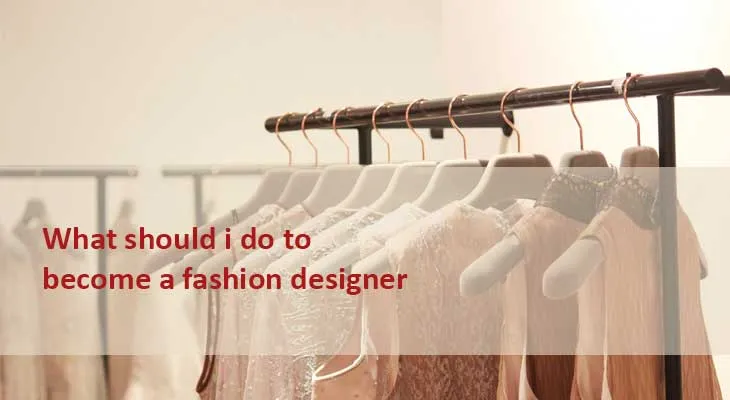


07, July 2022
Fashion design is a dynamic and creative field that allows individuals to express their artistic talent and contribute to the ever-evolving world of fashion. Becoming a successful fashion designer requires a combination of passion, dedication, and a solid understanding of the industry. In this comprehensive guide, we will explore the essential steps to help you embark on your journey towards becoming a fashion designer.
To become a fashion designer, it's crucial to develop a strong sense of fashion. Immerse yourself in the world of fashion by staying updated with the latest trends, following renowned designers, and regularly visiting fashion exhibitions and shows. Analyze different styles, colors, fabrics, and silhouettes to understand what appeals to you and what defines your unique aesthetic.
While not mandatory, obtaining a formal education in fashion design can provide a solid foundation for your career. Enroll in a reputable fashion design program or consider pursuing a degree in fashion design from a recognized institution. These programs will equip you with essential skills such as pattern-making, garment construction, textile knowledge, and fashion illustration.
To excel as a fashion designer, it's important to continuously hone your skills. Practice sketching designs, experiment with various fabrics, and learn about different sewing techniques. Familiarize yourself with design software such as Adobe Illustrator and Photoshop, as these tools are widely used in the industry. Additionally, internships or apprenticeships with established fashion houses can provide valuable hands-on experience and industry insights.
Creating a compelling portfolio is crucial for aspiring fashion designers. Compile your best designs and showcase your creativity, technical skills, and attention to detail. Include sketches, illustrations, photographs of garments you have created, and any other relevant work. A well-curated portfolio will help you make a strong impression on potential employers or clients.
The fashion industry is highly competitive and constantly evolving. Stay up to date with the latest fashion trends, technological advancements, and industry news. Attend fashion events, seminars, and workshops to expand your knowledge and network with industry professionals. Building relationships within the industry can lead to exciting opportunities and collaborations.
Consider gaining practical experience by working in different roles within the fashion industry. Seek internships or entry-level positions at fashion companies, fashion magazines, or design studios. This hands-on experience will provide valuable insights into the inner workings of the industry, develop your professional skills, and allow you to make industry connections.
To establish yourself as a fashion designer, it's essential to develop your personal brand. Define your unique style and create a cohesive brand identity. Build an online presence through a website or blog, and leverage social media platforms to showcase your work and engage with your target audience. Networking events and collaborations with other creatives can also help raise your profile.
As you progress in your fashion design career, consider pursuing further education or specialization in specific areas such as couture, sustainable fashion, or accessory design. Specializing can enhance your expertise and set you apart in the industry, opening doors to more opportunities.
Becoming a fashion designer requires a combination of passion, education, and practical experience. Here are the steps you can follow to embark on your journey toward becoming a fashion designer:
Start by immersing yourself in the fashion industry. Stay updated on the latest fashion trends, follow renowned designers, and attend fashion shows and exhibitions. Familiarize yourself with different styles, fabrics, and silhouettes to develop a strong fashion sense.
While not mandatory, a formal education in fashion design can provide a solid foundation for your career. Research and choose a reputable fashion design program or consider pursuing a degree in fashion design from a recognized institution. Look for programs that offer courses in design principles, garment construction, pattern-making, textile knowledge, and fashion illustration.
Hone your skills by practicing fashion sketching, experimenting with fabrics, and learning sewing techniques. Practice using design software like Adobe Illustrator and Photoshop, as they are widely used in the industry. Take advantage of any hands-on opportunities such as internships, apprenticeships, or part-time jobs in fashion companies or design studios to gain practical experience.
Create a compelling portfolio that showcases your creativity, technical skills, and unique style. Include your best designs, sketches, illustrations, photographs of garments you have created, and any other relevant work. A strong portfolio will help you demonstrate your abilities to potential employers or clients.
Networking is crucial in the fashion industry. Attend fashion events, seminars, and workshops to connect with industry professionals, including designers, stylists, and fashion editors. Join fashion organizations, participate in fashion competitions, and engage with fashion communities both online and offline. Building relationships can lead to valuable opportunities and collaborations.
Seek internships, entry-level positions, or freelance opportunities to gain practical experience in the fashion industry. Work in different roles within fashion companies, such as design assistants, pattern-makers, or production assistants. This hands-on experience will provide valuable insights into the industry and help you develop your skills further.
The fashion industry is ever-evolving, so it's crucial to stay updated on the latest trends, technologies, and industry news. Continuously learn and adapt to new developments and embrace change. Stay curious, attend workshops or courses, and expand your knowledge of fashion history, sustainability, and emerging design techniques.
Develop your personal brand as a fashion designer. Define your unique style and create a cohesive brand identity that reflects your aesthetic. Build an online presence through a website or blog, and utilize social media platforms to showcase your work and engage with your audience. Network with influencers, fashion bloggers, and industry professionals to increase your visibility.
Once you have built a strong foundation and gained experience, actively seek career opportunities in the fashion industry. Look for job openings at fashion houses, design studios, or fashion companies. You can also consider launching your own fashion label or working as a freelance designer.
Fashion is a constantly evolving industry, so it's important to never stop learning. Continuously seek opportunities for professional development, attend workshops, take courses, and stay open to new ideas and trends. Keep pushing the boundaries of your creativity and always strive to improve your skills.
Remember, becoming a successful fashion designer takes time and dedication. Stay focused on your goals, persevere through challenges, and let your passion for fashion guide you on your journey.
Becoming a successful fashion designer requires a combination of creativity, technical skills, industry knowledge, and perseverance. By following these essential steps, you can lay a solid foundation for your career in fashion design. Remember to stay true to your unique vision, continuously learn and adapt, and embrace the challenges that come with the ever-changing fashion landscape. With dedication and passion, you can turn your dream of becoming a fashion designer into a reality.